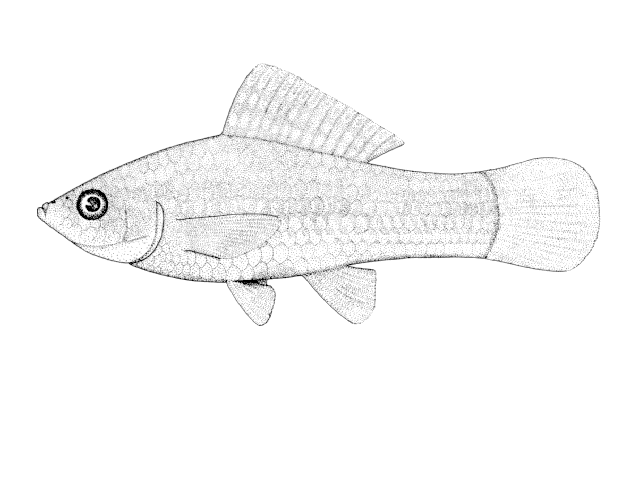Poecilia
latipinna
(Lesueur,
1821)
Sailfin molly
View all media / Upload your photos and videos
Expand all
Classification / Names
Teleostei (teleosts) > Cyprinodontiformes (Rivulines, killifishes and live bearers) >
Poeciliidae (Poeciliids)
> Poeciliinae
Etymology: Poecilia: Greek, poikilos = with a lot of colours (Ref. 45335).
latipinna: From the latin word latus (stem lat), meaning wide, broad, and pinna for fin (Ref. 79012).
More on author:
Lesueur.
Environment / milieu / depth range / climate zone / distribution range
Distribution
North America: Cape Fear drainage in North Carolina, USA to Veracruz, Mexico. Introduced to many countries. Several countries report adverse ecological impact after introduction. Gulf of Mexico (Ref. 26938).
Length at first maturity / Size / Weight / Age
Biology
Found in still or gently flowing warm water of small creeks and drains (Ref. 44894). Occurs in ponds, lakes, sloughs, and quiet, often vegetated, backwaters and pools of streams (Ref. 5723) and also in coastal waters (Ref. 7251). Abundant in tidal ditches and brackish canals. Feeds mainly on algae (Ref. 7251; 44091), also consumes animal material: rotifers, small crustaceans (such as copepods and ostracods) and aquatic insects (Ref. 79012).
Life cycle and mating behavior
After 28 days gestation, this species produces 10 to 100 young.
Main reference
Page, L.M. and B.M. Burr 1991 A field guide to freshwater fishes of North America north of Mexico. Houghton Mifflin Company, Boston. 432 p. (Ref. 5723)
IUCN Red List Status (Ref. 125652)
Least Concern (LC); date assessed: February 03 2019
CITES (Ref. 131153)
Not Evaluated
CMS (Ref. 116361)
Not Evaluated
Threat to humans
Potential pest
More information
- Countries
- FAO areas
- Ecosystems
- Occurrences
- Introductions
- Stocks
- Ecology
- Diet
- Food items
- Food consumption
- Ration
- Common names
- Synonyms
- Metabolism
- Predators
- Ecotoxicology
- Reproduction
- Maturity
- Spawning
- Spawning aggregation
- Fecundity
- Eggs
- Egg development
- Age/Size
- Growth
- Length-weight
- Length-length
- Length-frequencies
- Morphometrics
- Morphology
- Larvae
- Larval dynamics
- Recruitment
- Abundance
- References
- Aquaculture
- Aquaculture profile
- Strains
- Genetics
- Allele frequencies
- Heritability
- Diseases
- Processing
- Mass conversion
- Vision
- Pictures
- Stamps, Coins Misc.
- Sounds
- Ciguatera
- Speed
- Swim. type
- Gill area
- Otoliths
- Brains
Estimates based on models
Phylogenetic diversity index (Ref. 82804): PD50 = 0.5 [Uniqueness, from 0.5 = low to 2.0 = high].
Bayesian length-weight: a=0.01288 (0.00753 - 0.02204), b=3.06 (2.92 - 3.20), in cm total length, based on LWR estimates for this species & Genus-body shape (Ref. 93245).
Trophic level (Ref. 69278): 2.0 ±0.0 se; Based on food items.
Resilience (Ref. 120179): High, minimum population doubling time less than 15 months (tm<1; mutiple spawning per year; Fec=10--300).
Fishing vulnerability (Ref. 59153): Low vulnerability (10 of 100).
Price category (Ref. 80766): Unknown.
Nutrients (Ref. 124155): Calcium = 0 [0, 0] mg/100g; Iron = 0 [0, 0] mg/100g; Protein = 0 [0, 0] %; Omega3 = 0 [0, 0] g/100g; Selenium = 0 [0, 0] μg/100g; VitaminA = 0 [0, 0] μg/100g; Zinc = 0 [0, 0] mg/100g (wet weight);










